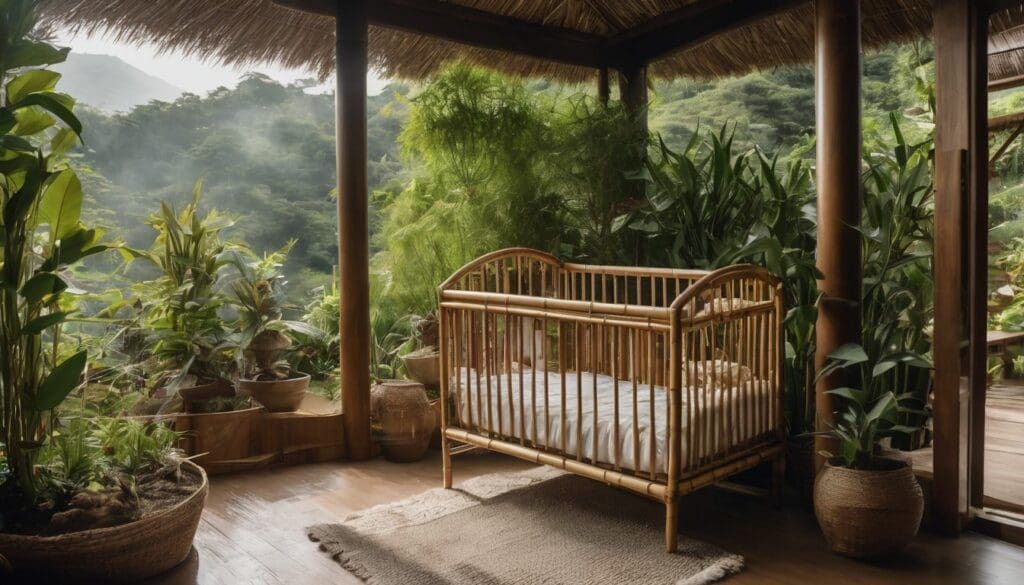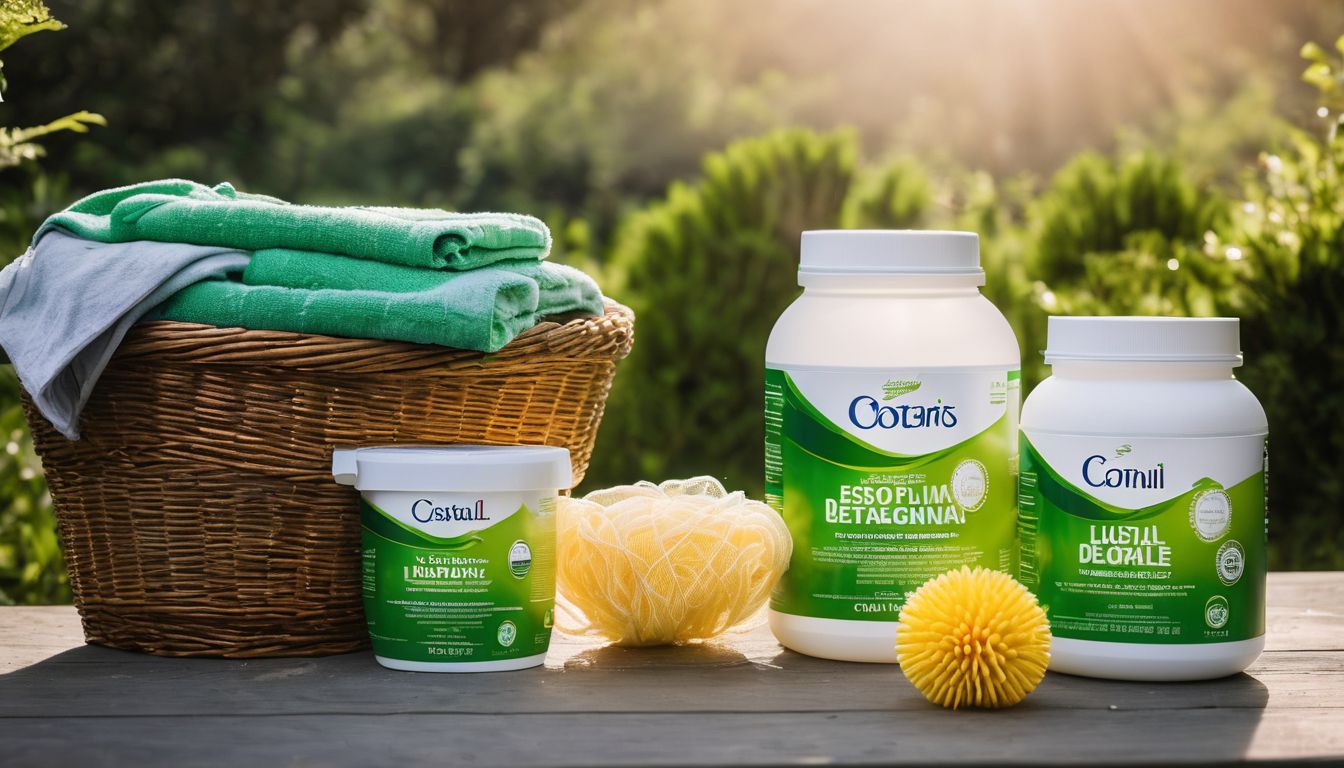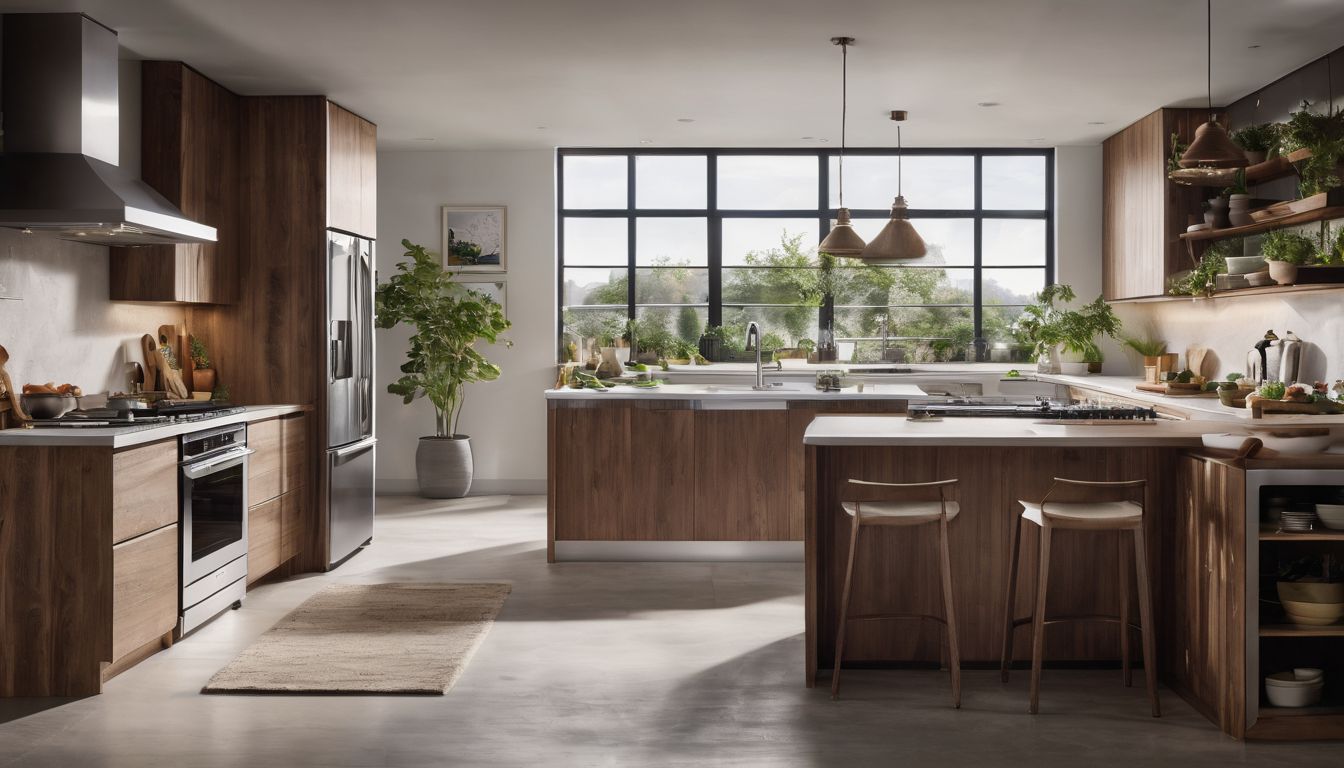Creating an eco-friendly nursery is a task many environmentally conscious parents face. Did you know that choosing natural materials can significantly reduce your child’s exposure to harmful chemicals? This blog post will guide you through the essentials of designing a sustainable and safe space for your little one.
Get ready to transform your nursery into a green haven!
Key Takeaways
- Choose eco – friendly materials with certifications like GOTS or FSC to ensure they are sustainable and safe for your baby. Bamboo and organic cotton are great choices for furniture, bedding, and clothing.
- Opt for low VOC paint in the nursery to avoid toxic fumes and select natural flooring like bamboo or cork to keep harmful chemicals at bay.
- Invest in durable, versatile furniture that can grow with your child, reducing waste over time. Consider multi-purpose items and look out for second-hand pieces which can save resources and add character.
- Use natural cleaning products in the nursery to protect your baby from harsh chemicals. Create DIY cleaners using household ingredients like vinegar and baking soda for a green cleaning solution.
- Embrace cloth diapering as an alternative to disposables; modern designs make them convenient while saving on waste. Add indoor plants that purify the air, introducing nature into the nursery environment.
Choosing Sustainable Materials
When creating an eco-friendly nursery, it’s important to choose sustainable materials. Look for eco-friendly certifications and consider materials such as bamboo and organic cotton.
These options are better for the environment and your baby’s health.
Look for eco-friendly certifications
Check for labels that show a product’s green credentials. Products with certifications like the Global Organic Textile Standard (GOTS) or Forest Stewardship Council (FSC) are trustworthy choices.
These badges ensure materials come from sustainable sources and meet rigorous environmental and social standards. Opting for items with eco-friendly symbols helps reduce your nursery’s carbon footprint.
Trust in certified ecoconscious products to create a healthier environment for your baby. Certifications guide you towards responsible consumption, promoting both child safety and earth-friendly practices.
Next, explore the benefits of bamboo, organic cotton, and other natural materials to further enhance your green nursery.
Consider materials such as bamboo and organic cotton
Opt for sustainable materials like bamboo and organic cotton to reduce environmental impact. Look for eco-friendly certifications to ensure the products align with your values. Bamboo is a renewable resource that grows quickly, making it an excellent option for furniture and bedding.
Organic cotton avoids harmful pesticides and chemicals, providing a natural and safe choice for baby clothing and bedding. By choosing these materials, you contribute to a healthier planet for future generations.
When designing an eco-friendly nursery, consider using materials such as bamboo and organic cotton. These options are sustainable and environmentally friendly, fitting seamlessly into an eco-conscious lifestyle.
Non-toxic Options for Walls and Flooring
Opt for low VOC paint and natural, non-toxic materials for the walls and flooring of the nursery. This will create a safe and healthy environment for your baby.
Use low VOC paint
Choose low VOC paint for the nursery to reduce harmful emissions. Look for brands with eco-friendly certifications like Green Seal or Greenguard to ensure a healthier environment for your baby.
Opting for low VOC paint minimises exposure to toxic fumes and contributes to better air quality in the nursery, promoting a safer and more comfortable space.
Transform the nursery with low VOC paint, promoting a healthy and sustainable environment while avoiding any potential health risks. Selecting non-toxic options like low VOC paint ensures that the nursery remains free of harmful chemicals, providing peace of mind for environmentally conscious parents.
Choose natural and non-toxic materials for flooring
Opt for natural and non-toxic flooring materials, such as sustainably sourced bamboo or cork. Look for eco-friendly certifications when selecting carpets or rugs, ensuring they are made from organic cotton or wool to reduce exposure to harmful chemicals like formaldehyde.
Prioritise low VOC paint coatings that emit fewer toxic substances into the air, creating a safer nursery environment for your little one.
Consider environmentally friendly options like linoleum or hardwood floors which are durable and sustainable choices for an eco-conscious nursery. Opting for these natural flooring alternatives can minimise the impact on both your baby’s health and the environment while maintaining a stylish aesthetic in the space.
Quality Furniture
Invest in durable and sustainable furniture pieces for the nursery, considering multi-purpose items to reduce waste and maximise space. Using high-quality, long-lasting furniture will help create an eco-friendly and practical baby room.
Invest in durable and sustainable furniture pieces
Choose durable and sustainable furniture pieces for your eco-friendly nursery. Look for items made from responsibly sourced materials such as bamboo or reclaimed wood, ensuring they are free from harmful chemicals.
Consider versatile furniture that can adapt to your child’s changing needs over time, reducing the need for constant replacements. This approach not only supports sustainability but also provides a safe and healthy environment for your little one.
Consider multi-purpose furniture options that grow with your child while maintaining an eco-conscious mindset towards a sustainable future.
Consider multi-purpose furniture
Look for furniture that serves dual purposes, such as a crib with built-in storage or a changing table that converts into a dresser. Look for sustainable and durable pieces that can adapt to your child’s growing needs without losing their functionality.
This will help conserve space and reduce the need for extra furniture, contributing to the eco-friendly nature of the nursery. Opting for multi-purpose furniture supports sustainability while promoting practicality in an environmentally conscious manner.
Investing in multi-functional furniture allows you to maximise the use of each item while reducing waste and supporting environmental conservation efforts. By choosing versatile pieces, you can minimise the need for excess furnishings and contribute to a more sustainable nursery environment.
Second-Hand and Local Shopping
Reduce waste and support local businesses by looking for gently used items or repurposing old furniture for your eco-friendly nursery.
Reduce waste and support local businesses
To reduce waste and support local businesses, consider shopping for nursery items at nearby stores or farmers’ markets. Look for gently used furniture and décor, which not only reduces waste but also supports the local economy.
Repurposing old furniture is another eco-friendly way to furnish the nursery while minimising environmental impact. By choosing second-hand and locally sourced items, you can create a sustainable and environmentally friendly space for your baby.
When buying nursery supplies, opt for products with eco-friendly certifications that support ethical production practices. Purchasing from local artisans or businesses can positively impact the environment by reducing transport emissions and supporting sustainable practices in your community.
Look for gently used items or repurpose old furniture
Supporting local businesses and reducing waste can go hand in hand when creating an eco-friendly nursery. Look for gently used items or repurpose old furniture to give them a new life.
This not only minimises the demand for new resources but also adds a unique and personal touch to the nursery decor, creating a one-of-a-kind space for your little one.
Eco-Friendly Cleaning and Diapering
For a more eco-friendly nursery, consider using natural cleaning products and cloth diapering as an alternative to disposable diapers. These options not only reduce your environmental footprint but also provide a safer and healthier environment for your baby.
Use natural cleaning products
Opt for natural cleaning products in the nursery to reduce exposure to harsh chemicals. Look for eco-friendly labels such as “biodegradable” and “non-toxic” when choosing cleaning supplies, promoting a healthier environment for your baby.
Consider making your own natural cleaners using ingredients like vinegar, baking soda, and essential oils. These options are gentle yet effective, ensuring a safe and environmentally friendly space for your little one.
By using natural cleaning products, you’re contributing to a cleaner, greener future while protecting your baby from unnecessary exposure to harmful substances.
Consider cloth diapering for a more eco-friendly option
After ensuring a natural and non-toxic nursery environment, you can take eco-friendly diapering a step further by considering cloth diapers. Cloth diapers are reusable and reduce waste significantly compared to disposable ones.
They also eliminate the use of harmful chemicals found in disposable diapers, making them an excellent choice for environmentally conscious parents. By incorporating cloth diapering into your nursery routine, you’ll be contributing to a more sustainable future for the next generation.
Cloth diapering is not only eco-friendly but also cost-effective in the long run. With advancements in design and materials, modern cloth diapers are convenient to use and washable, making them a practical choice for green parenting.
Incorporating Plants
Purify the air and add a touch of nature to the nursery with indoor plants. Greenery not only adds decoration but also helps to improve air quality, creating a healthier environment for your baby.
Purify the air and add a touch of nature to the nursery
Incorporate air-purifying plants like snake plants and spider plants to improve air quality. Choose low-maintenance options such as aloe vera and peace lilies for a natural, eco-friendly nursery environment.
Plants also add a calming ambience and introduce the concept of sustainability to your child from an early age.
Add life and colour by incorporating hanging or potted plants above furniture or in corners. Utilise sustainable planters made from recycled materials, contributing to an environmentally friendly space that benefits both you and your baby.
Conclusion
Create an eco-friendly nursery by choosing sustainable materials such as bamboo and organic cotton. Use low VOC paint for walls and consider natural, non-toxic flooring options. Look for durable, second-hand furniture and incorporate plants to purify the air.
Utilise natural cleaning products and consider cloth nappies for a more eco-conscious approach.
FAQs
1. What does it mean to have an eco-friendly nursery?
An eco-friendly nursery means you create a baby room with the environment in mind, using non-toxic and natural products that are safe for your baby and the planet.
2. How can I ensure my nursery is environmentally friendly?
You can choose organic or natural materials for bedding and furniture and use eco-conscious products to reduce harm to the earth in your green baby nursery.
3. Where do I find eco-friendly items for my baby’s room?
Look for stores or online shops that specialise in environmentally conscious goods. They offer a range of eco-friendly products perfect for creating an earth-friendly nursery.
4. Is it expensive to set up an organic nursery?
Setting up an organic nursery can be affordable! Many brands offer a variety of reasonably priced non-toxic and organic options suitable for every budget.
5. Can I still have stylish decor in an eco-conscious baby nursery?
Absolutely! There are many beautiful, stylish options available that comply with environmentally friendly standards, allowing you to design a chic yet eco-conscious baby room.





